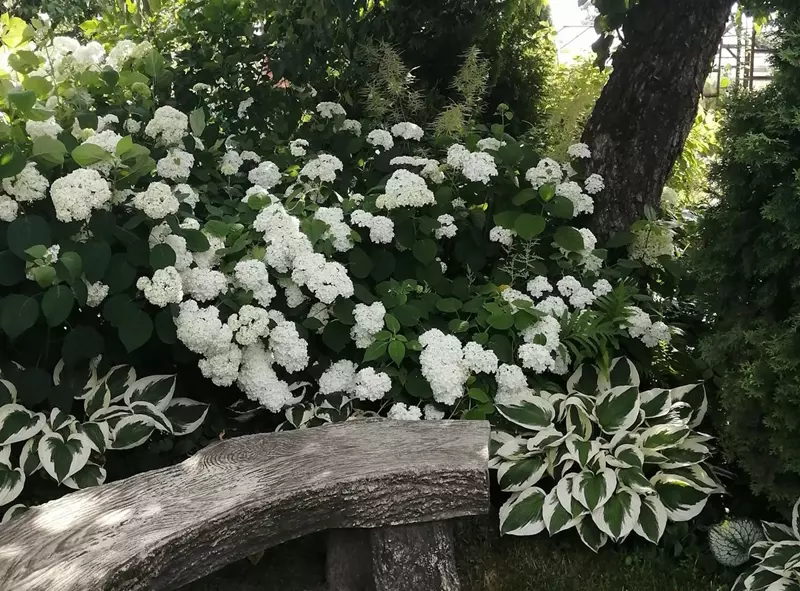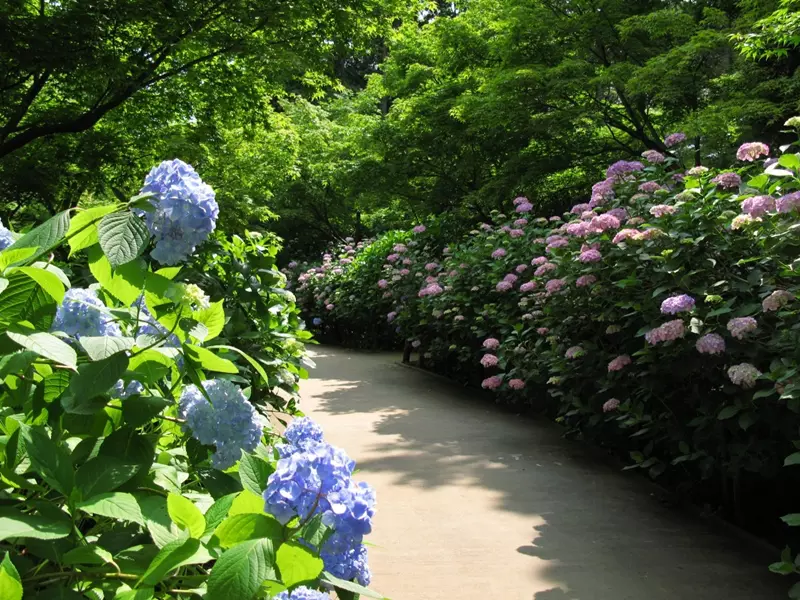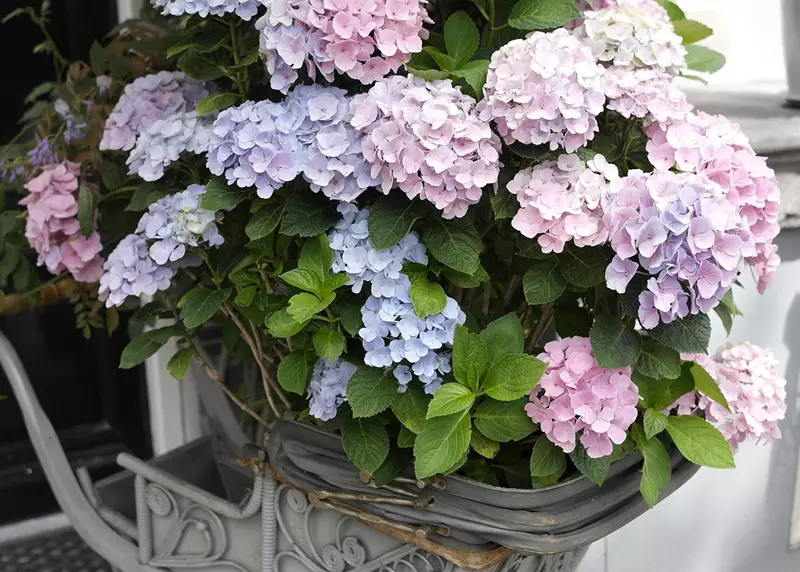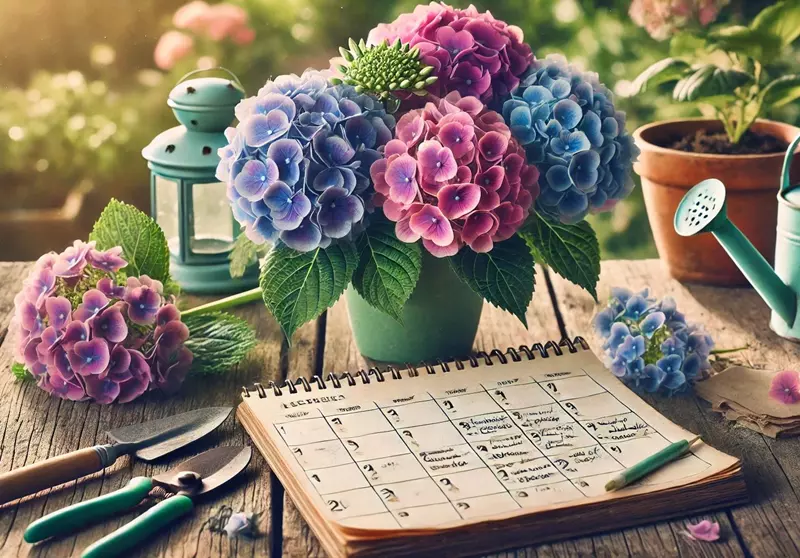Table of Contents
Hydrangeas are beloved for their large, vibrant blooms and adaptability to various garden settings. While many hydrangea species thrive in full sun, several varieties are well-suited for shaded gardens, bringing colour and texture to less sunny spots. This guide will provide detailed insights into cultivating hydrangeas in shaded environments, ensuring healthy growth and abundant flowering.
 Hydrangeas in a Shaded Garden - Source: pexels.com; Author: Ksenia I; License: Pexels License
Hydrangeas in a Shaded Garden - Source: pexels.com; Author: Ksenia I; License: Pexels License
Selecting Shade-Tolerant Hydrangea Varieties
Understanding Shade Conditions
Before selecting a hydrangea variety, it's crucial to assess the specific shade conditions in your garden:
- Partial Shade: Areas receiving 3-6 hours of direct sunlight, typically during the morning or late afternoon. Many hydrangeas flourish in these conditions.
- Full Shade: Locations with less than 3 hours of direct sunlight, often under dense tree canopies or beside structures. Only certain hydrangea varieties are suitable for these areas.
Top Shade-Tolerant Hydrangea Varieties
1. Bigleaf Hydrangea (Hydrangea macrophylla)
Known for their large, mophead or lacecap flowers, Bigleaf Hydrangeas are well-suited for partial shade. Their bloom colour can vary from pink to blue, influenced by soil pH. Notable cultivars include:
- 'Nikko Blue': Produces vibrant blue flowers in acidic soils; prefers partial shade and moist, well-drained soil.
- 'Endless Summer': A reblooming variety offering pink or blue flowers depending on soil pH; thrives in partial shade.
2. Oakleaf Hydrangea (Hydrangea quercifolia)
Distinguished by their oak-shaped leaves and elongated flower panicles, Oakleaf Hydrangeas perform excellently in partial to full shade. They also provide striking autumn foliage. Recommended cultivars include:
- 'Snow Queen': Features large, white flower panicles that age to pink; tolerates full shade and offers brilliant red-purple autumn leaves.
- 'Pee Wee': A compact variety with white blooms turning pink; ideal for smaller gardens and shaded areas.
3. Mountain Hydrangea (Hydrangea serrata)
Native to mountainous regions, these hydrangeas are more compact and hardy, making them suitable for partial shade. They produce delicate lacecap flowers. Notable cultivars include:
- 'Bluebird': Offers blue to lavender lacecap flowers; thrives in partial shade with consistent moisture.
- 'Preziosa': Displays pink flowers that deepen in colour as they mature; adaptable to various shade conditions.
4. Climbing Hydrangea (Hydrangea anomala subsp. petiolaris)
Ideal for covering shaded walls or fences, Climbing Hydrangeas are vigorous climbers that produce fragrant white flowers in early summer. They prefer partial to full shade and well-drained, moist soil.
Considerations for Planting in Shade
When introducing shade-tolerant hydrangeas to your garden, consider the following:
- Soil Quality: Ensure the soil is rich in organic matter and well-draining to support healthy root development.
- Moisture Levels: Shaded areas can retain moisture longer; however, it's essential to maintain consistent watering, especially during dry periods.
- Air Circulation: Adequate spacing between plants promotes air flow, reducing the risk of fungal diseases common in shaded, humid environments.
Selecting the right shade-tolerant hydrangea variety can transform dimly lit garden areas into vibrant displays of colour and texture. By understanding your garden's specific shade conditions and choosing appropriate hydrangea species, you can enjoy these beautiful blooms even in the shadiest corners.
Choosing the Right Planting Location
Understanding Shade Levels
Hydrangeas are versatile shrubs that can adapt to various light conditions, but selecting the appropriate planting location is crucial for their success in shaded gardens. Understanding the different levels of shade will help in making informed decisions:
- Partial Shade: Areas receiving 3-6 hours of direct sunlight, typically during the morning or late afternoon. This is ideal for many hydrangea varieties.
- Full Shade: Locations with less than 3 hours of direct sunlight, often under dense tree canopies or beside structures. Only specific hydrangea species thrive here.
- Dappled Shade: Spots where sunlight filters through overhead foliage, creating a pattern of light and shadow. Many hydrangeas flourish in these conditions.
Optimal Planting Locations for Shade-Tolerant Hydrangeas
Choosing the right spot in your garden involves considering both light exposure and environmental factors:
- East or North-Facing Walls: These areas receive gentle morning light and are shielded from harsh afternoon sun, making them suitable for hydrangeas like the Climbing Hydrangea (Hydrangea anomala subsp. petiolaris).
- Under Deciduous Trees: The filtered light through the canopy provides dappled shade, ideal for varieties such as the Oakleaf Hydrangea (Hydrangea quercifolia).
- Woodland Gardens: Mimicking their native habitats, woodland settings with rich, moist soil and consistent shade are perfect for Mountain Hydrangeas (Hydrangea serrata).
Soil Considerations
Hydrangeas prefer moist but well-drained soil rich in organic matter. In shaded areas, soil can retain moisture longer, so it's essential to ensure proper drainage to prevent root rot. Amending the soil with compost or well-rotted manure can enhance fertility and structure.
Moisture and Irrigation
While shaded locations may reduce evaporation, consistent watering is still vital, especially during establishment and dry periods. Hydrangeas in full shade might require less frequent watering, but it's crucial to monitor soil moisture levels to maintain optimal hydration.
Air Circulation
Good air circulation helps prevent fungal diseases, which can be more prevalent in shaded, humid environments. Ensure adequate spacing between plants and avoid overcrowding to promote healthy airflow around your hydrangeas.
Protection from Environmental Stressors
Shaded areas can offer protection from environmental stressors such as strong winds and extreme temperatures. However, it's essential to avoid planting in frost pockets or areas prone to waterlogging, as these conditions can adversely affect hydrangea health.
Selecting the appropriate planting location for hydrangeas in shaded gardens involves understanding the nuances of shade levels, soil conditions, moisture management, and environmental factors. By carefully assessing your garden's specific conditions and choosing suitable spots, you can ensure that your shade-tolerant hydrangeas thrive and enhance the beauty of your landscape.
Soil Preparation and Planting
Understanding Soil Requirements
Hydrangeas are renowned for their adaptability, yet they flourish best in soils that meet specific criteria:
- Moisture: Hydrangeas prefer moist soils that are not prone to waterlogging. Improving the soil and mulching with organic matter, such as garden compost or a manure-based soil conditioner, will help to keep soil moist.
- Drainage: While they favour moisture, hydrangeas dislike waterlogged conditions. Ensuring proper drainage is essential to prevent root rot.
- pH Levels: The pH of the soil can influence the flower colour of some hydrangea varieties. For instance, acidic soils can produce blue flowers, while alkaline soils may result in pink blooms.
Soil Preparation Steps
Proper soil preparation is crucial for the successful establishment of hydrangeas in shaded gardens:
- Assess Soil Drainage: Dig a test hole and fill it with water. If it drains within a few hours, the drainage is adequate. If not, consider amending the soil or choosing a different planting site.
- Amend the Soil: Incorporate organic matter such as well-rotted manure or compost to improve soil structure, fertility, and moisture retention. This is particularly beneficial for light soils.
- Adjust Soil pH: If aiming for specific flower colours, test the soil pH and amend accordingly. For bluer blooms, acidify the soil; for pinker hues, increase alkalinity.
Planting Hydrangeas
Follow these steps to plant hydrangeas effectively:
- Timing: The best time to plant hydrangeas is in spring or autumn, when the soil is warm and moist.
- Pre-Soaking the Plant: Before planting, submerge the potted hydrangea completely in a bucket of water. Press the pot down so that the soil is underwater, and keep it submerged until bubbles stop rising to the surface. This process, which takes 1-2 minutes, ensures that the plant's root ball is thoroughly hydrated and reduces the risk of drying out after planting.
- Watering Before Planting: After pre-soaking, water the planting area generously to prepare the soil.
- Digging the Hole: Dig a hole about twice the width of the pot and deep enough for the root ball to sit at the same depth as it was in its container.
- Planting Depth: Never plant a hydrangea deeper than it was in its original pot. Water in well.
- Firming the Soil: After placing the hydrangea in the hole, refill the hole with soil and gently firm it down around the roots. Use your hands or even your feet to press the soil down firmly. This step is critical as it ensures good contact between the roots and the surrounding soil, which is essential for proper water and nutrient absorption.
- Mulching: Apply a 5–7 cm layer of organic mulch, such as leaf mould, around the base of the plant to conserve moisture and regulate soil temperature.
Post-Planting Care
After planting, ensure the following to promote healthy growth:
- Watering: Keep the plant well watered throughout its first spring and summer.
- Protection from Frost: The young growth of hydrangeas is prone to frost damage in spring, so avoid planting in a frost pocket, and plant away from strong winds.
- Mulching: Mulch in spring to improve soil moisture retention.
Proper soil preparation and planting techniques are vital for the successful cultivation of hydrangeas in shaded gardens. By understanding and addressing their specific soil and planting needs, you can ensure that your hydrangeas establish well, leading to healthy growth and abundant blooms in the seasons to come.
Watering and Mulching Hydrangeas in Shaded Gardens
Importance of Proper Watering
Hydrangeas, especially those situated in shaded gardens, require consistent moisture to thrive. While shade can help retain soil moisture, it's essential to monitor and maintain appropriate watering practices to ensure optimal growth and vibrant blooms.
Watering Guidelines
- Consistent Moisture: Aim to keep the soil consistently moist but not waterlogged. Overwatering can lead to root rot, while underwatering may cause wilting and poor flower development.
- Deep Watering: Water deeply at the base of the plant to encourage robust root growth. This method ensures that water reaches the root zone, promoting healthier and more resilient plants.
- Watering Schedule: Generally, hydrangeas require about 1 inch (2.5 cm) of water per week. However, factors such as soil type, climate, and specific garden conditions may necessitate adjustments. Regularly check the soil moisture and adapt your watering routine accordingly.
- Morning Watering: Watering in the early morning allows foliage to dry throughout the day, reducing the risk of fungal diseases. It also ensures that plants have adequate moisture during the hottest parts of the day.
Benefits of Mulching
Applying mulch around your hydrangeas offers several advantages:
- Moisture Retention: Mulch reduces water evaporation from the soil, ensuring consistent moisture levels that hydrangeas need for vibrant blooms.
- Temperature Regulation: A layer of mulch helps maintain stable soil temperatures, protecting roots from extreme heat or cold.
- Weed Suppression: By blocking sunlight, mulch prevents weed growth, reducing competition for nutrients and water.
- Soil Improvement: Organic mulches decompose over time, enriching the soil with essential nutrients and improving its structure.
Mulching Best Practices
- Mulch Selection: Choose organic materials such as wood chips, bark mulch, or shredded leaves. These options decompose naturally, enhancing soil fertility.
- Application Depth: Apply a 5–7 cm (2–3 inches) layer of mulch around the base of the hydrangea. This depth is sufficient to retain moisture and suppress weeds without suffocating the roots.
- Proper Placement: Keep mulch a few centimetres away from the stem of the plant to prevent rot and allow for adequate air circulation around the base.
- Seasonal Renewal: Refresh the mulch layer annually, preferably in spring, to maintain its effectiveness and continue providing benefits to the plant.
Monitoring and Adjustments
Regularly assess soil moisture by checking the top few centimetres of soil. If it feels dry, it's time to water. Additionally, observe your hydrangeas for signs of stress, such as wilting or yellowing leaves, and adjust your watering and mulching practices accordingly to address any issues promptly.
Implementing proper watering and mulching techniques is crucial for the health and beauty of hydrangeas in shaded gardens. By maintaining consistent moisture levels and protecting the soil environment, you can ensure your hydrangeas flourish, providing lush foliage and abundant, vibrant blooms throughout the growing season.
Pruning and Maintenance
The Importance of Pruning
Pruning is a vital aspect of hydrangea care, ensuring healthy growth, vibrant blooms, and a well-maintained structure. For hydrangeas grown in shaded gardens, pruning plays an even more critical role as it helps improve light penetration and air circulation, which are essential in low-light conditions.
When to Prune
The timing of pruning is crucial, particularly in climates where winter frosts occur:
- Spring Pruning: In regions with frosty winters, prune hydrangeas in early spring, around March, after the risk of frost has passed. This allows you to assess any winter damage and remove affected parts effectively.
- Avoid Autumn Pruning: Contrary to popular belief, autumn pruning should be avoided. Leaving the stems intact over winter provides the plant with a buffer against frost damage. If frost occurs, the plant can "die back" to older stems without severely impacting its vitality.
How to Prune Hydrangeas
The pruning method depends on the specific hydrangea variety:
- Bigleaf Hydrangeas (Hydrangea macrophylla): These bloom on old wood. Prune immediately after flowering, removing spent blooms and thinning out older stems to encourage new growth.
- Oakleaf Hydrangeas (Hydrangea quercifolia): Similar to Bigleaf varieties, these also flower on old wood. Prune after flowering and remove only dead or damaged stems.
- Panicle and Smooth Hydrangeas (Hydrangea paniculata and Hydrangea arborescens): These bloom on new wood. Prune in early spring before growth begins, cutting back stems to 30-50 cm to promote vigorous flowering.
- Climbing Hydrangeas (Hydrangea anomala subsp. petiolaris): Minimal pruning is required. Remove any dead or overcrowded stems in early spring to maintain shape.
Winter Preparation
In colder climates, protecting hydrangeas during winter is essential. By delaying pruning until spring, you allow the plant to retain its natural defences against frost. Additionally, applying a layer of mulch around the base can insulate roots and prevent damage from freezing temperatures.
General Maintenance Tips
Beyond pruning, regular maintenance ensures the overall health and longevity of your hydrangeas:
- Remove Deadwood: Regularly inspect the plant and remove dead or damaged stems to prevent disease and improve air circulation.
- Fertilisation: Apply a balanced, slow-release fertiliser in spring to support healthy growth and flowering.
- Weed Control: Keep the area around the base of the plant free from weeds, which can compete for nutrients and water.
- Monitor for Pests: Check for common pests like aphids and take prompt action to prevent infestations.
Pruning and maintenance are essential for the health and beauty of hydrangeas in shaded gardens. By pruning at the right time, especially in frost-prone regions, and following proper maintenance practices, you can ensure your hydrangeas remain vibrant and healthy, producing lush blooms year after year.
Common Issues and Solutions for Hydrangeas in Shaded Gardens
1. Limited Flowering
Insufficient sunlight is a primary cause of reduced blooming in hydrangeas. While these plants tolerate shade, they require some sunlight to produce flowers.
Solution:
- Optimal Placement: Ensure hydrangeas receive morning sun and afternoon shade. This balance promotes flowering while protecting the plants from intense midday heat.
- Pruning: Regularly prune to remove dead or weak stems, enhancing light penetration and air circulation within the plant. This practice encourages the development of flower buds.
2. Weak or Leggy Growth
In deep shade, hydrangeas may exhibit elongated stems as they stretch toward light, resulting in a sparse and weak appearance.
Solution:
- Selective Thinning: Prune overcrowded branches to allow more light to reach the inner parts of the plant, promoting sturdier growth.
- Support Structures: Use stakes or frames to support weak stems, preventing damage and maintaining an upright habit.
3. Powdery Mildew
Shaded and humid conditions can foster the development of powdery mildew, a fungal disease that appears as a white, powdery coating on leaves.
Solution:
- Improved Air Circulation: Space plants adequately and prune to reduce overcrowding, enhancing airflow and reducing humidity around foliage.
- Fungicidal Treatment: Apply appropriate fungicides at the first sign of infection to control the spread of powdery mildew.
4. Leaf Spot Diseases
Excess moisture and limited air movement in shaded areas can lead to fungal leaf spot diseases, causing brown or black spots on foliage.
Solution:
- Watering Practices: Water at the base of the plant to keep foliage dry, and water in the morning to allow any moisture on leaves to evaporate during the day.
- Sanitation: Remove and dispose of affected leaves to prevent the spread of pathogens.
5. Nutrient Deficiencies
Shaded soils may have reduced nutrient availability, leading to deficiencies that manifest as chlorosis (yellowing leaves) or poor growth.
Solution:
- Soil Testing: Conduct a soil test to identify nutrient deficiencies and amend the soil accordingly with appropriate fertilisers.
- Organic Mulching: Apply organic mulch to improve soil fertility and structure over time.
6. Pest Infestations
Shaded gardens can attract pests such as aphids and slugs, which may damage hydrangeas.
Solution:
- Regular Inspection: Monitor plants frequently for signs of pests and take early action to control infestations.
- Natural Predators: Encourage beneficial insects like ladybirds, which prey on aphids, to maintain pest populations in check.
Growing hydrangeas in shaded gardens presents unique challenges, but with attentive care and appropriate interventions, these issues can be effectively managed. By understanding and addressing the specific needs of hydrangeas in low-light environments, gardeners can enjoy the beauty and elegance these plants bring to shaded landscapes.
Growing hydrangeas in shaded gardens can be a rewarding endeavour with the right variety selection and care. By providing suitable light conditions, preparing the soil adequately, maintaining consistent moisture, and performing timely pruning, your hydrangeas will flourish, adding beauty and elegance to your garden sanctuary.
About the Author

Richard Seres-Nagy is a passionate gardener with over 20 years of experience in hydrangea care. He founded Hydrangea Library to share expert advice, step-by-step guides, and practical tips for fellow gardening enthusiasts.
Read More




